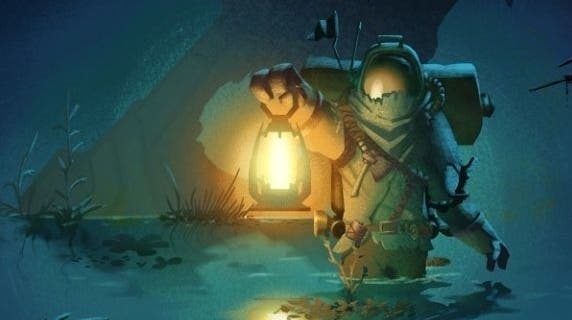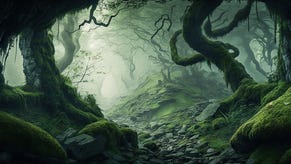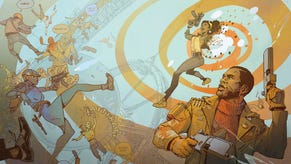Outer Wilds Echoes of the Eye review - a wondrous, spooky addition to the solar system
Look again.
Discovery and realisation are the two great thrills of Outer Wilds, so let me dust off an old reviewer's cliche and say that if you loved that game you should stop reading and play Echoes of the Eye without further ado. Nothing I can write will be as compelling as unravelling this first and only expansion for yourself.
Indeed, writing takes a backseat in Echoes of the Eye - as, rather unexpectedly, does spaceflight. Where Eurogamer's best of 2019 saw you chasing clues from gravity well to gravity well, hurrying to make sense of a pocket solar system before the sun explodes and resets the game's 22 minute timeloop, Echoes takes place almost entirely on one, mesmerising new world with its own, self-sealed mode of traversal. It's the erstwhile home of an alien race whose language you don't know, and whose torrid past you must accordingly glean from images that are equal parts Kodak Moment and found footage eeriness. Fortunately, your ship computer still does a solid job of paraphrasing key findings and mind-mapping them for consideration, bolstered by a menu tweak that lets you organise leads by planet.
The newfound prominence of images is about more than minimising exposition. It supports environment puzzles that deal, like the original game's quantum experiments, with how observation affects the observed, but Echoes sneakily transports those notions into the realm of the occult. Think solar eclipses and eldritch green flames, portraits you fear to turn your back on and that particular breed of gloom that lurks inside pinewood hunting lodges from the American Midwest. There are folding metal contraptions that recall the spikes and siphons of the Amnesia series, but this isn't an outright horror story, and you can always turn the spookier moments off in the settings (though I haven't had a chance to replay and see what this does in practice). Much of Echoes takes place in bracing sunlight, where you'll wrestle anew with physics and explore without worrying about oxygen reserves, and - well, I've already spoiled far too much, and somehow, you are still reading. OK then. Let's button up our spacesuits and push on.
But first, a few words about how Echoes fits into what already makes Outer Wilds so special. The game stands out among sci-fi exploration sims for the tactile intuitiveness of its moving parts at every scale. However huge and often threatening, its solar system has the accessibility and consistency of a lovingly made toy. Whether you're talking about stormy gas giants or starcraft that are steered by rolling marbles along tubes, the machinery is at once weird and hazardous and pleasingly coherent in the hands, a thing to grasp and play with (and be suddenly crushed by), a thing you can imagine cobbling together yourself. Outer Wilds synchronises the little to the large, mirroring itself religiously. Its cosmos - a descendant of the clockwork orreries of early European astronomers - houses astrophysical models of its own, from dusty museum exhibits to magic sandtray holograms.
It is a glittering fractal timepiece, all teetering chaos and tidal forces rendered soothingly predictable by those 22 minute resets. Echoes of the Eye, meanwhile, is a projector. The action of light through a surface is the add-on chapter's defining motif. It's the means by which you both locate the new world and expose its secrets, using your helmet torch and locally obtained lanterns to reveal backstory and trigger mechanisms beneath the crust.
The world itself is a ring world, a beautiful ribbon of riverside architecture circling a miniature sun, which evokes not just Halo and Larry Niven but Kodak's legendary carousel machine and the lush artificiality of Myst. That river gives the expansion its touch of uncomplicated joy: you'll get around on high tech rafts, pointing your torch to steer, and the true-to-life recreation of water physics is a pleasure even when the rapids drag you under and smash your face against a rock.


The river also gives the Stranger its instability. Like the Ember Twins and Brittle Hollow, this is a setting in the midst of cataclysmic change. Midway through each timeloop a dam bursts, sending a tidal wave rampaging around and overhead that strategically rearranges the architecture, sealing off certain secrets while exposing others. As with the main game, progress is about visiting different places at different points in the cycle, dredging up more and more information till you eventually have enough to perform some action that brings this sidestory to a close. Light-based puzzles aside, you'll launch probes through cracks to recon collapsed chambers, track down strings of symbols and become master of the river, with some areas found by travelling against the current or tunnelling beneath the waves. I'm not sure Echoes has any "aha" moments to rival, say, the Quantum Moon, but the expansion unpacks the projection theme very elegantly, and the story's major revelations are more than worth the journey.
As for the creatures who once lived here - again, I'm wary of giving away too much, but suffice to say that deprioritising text is a brilliant evolution of Outer Wilds' approach to storytelling, and the Strangers are a delightful contrast to the ancient Nomai explorers you'll study in the main game. The Nomai are a chatty bunch, and generally sympathetic. You perceive them as roamers and tinkerers, comrades-in-arms whose motivations admittedly grow more sinister as their story goes on. Their way of writing - spirals that beget spirals, with responses grafted to statements to create exquisite flowering designs - playfully evokes the complex gravitational entanglements that make up the game's cosmos.

The Strangers, by contrast, are rigid and menacing in their silence. Often depicted without visible mouths, they express themselves instead through murals, portraits and half-burned slide reels that form stop-motion videos of prophecy and apocalypse, lifted by ominous musical strains. You haunt the Nomai in a way, always hovering on the edge of their winding conversations. But you are haunted by the Strangers. They aren't malicious, exactly, but they are afflicted by despair in ways the Nomai never are, a despair that saturates their haven for all its resemblance to an idyllic hunting resort, with deck chairs and fishing rods alongside the curious machines. They are also bigger than the player's character, their furniture and devices dwarfing you in their absence. If there's a hint of Amnesia to the backstory, a more straightforward comparison here is Goldilocks and the Three Bears.
If you didn't like Outer Wilds, I'm not sure Echoes will do much for you. All the 2019 game's slight frustrations are back, though you at least won't spend as much time crash-landing on planets or being eaten by fish. The world's running order can't be gainsaid, though you can doze at campfires to fast forward: mistime a crucial jump, or get swept away by the current, and you'll have to twiddle your thumbs till the supernova comes. It's also a little irritating that you can't add images from slide reels to your ship's databanks, just a summary of their content, so if there's a detail you missed in one loop, you'll need to track down that reel again in the next. All of which is, I would argue, a small price to pay for inhabiting a stage production of this intricacy and grandeur, and the platforming is pretty gentle next to the mixed-gravity spelunking of Brittle Hollow or the cyclones of Giant's Deep.
The worst thing about Outer Wilds's first expansion, from my perspective, is that there won't be another one. Which is also, of course, the expansion's best quality, because the last thing I want for this game is anything like the endless, itemisable sprawl of a No Man's Sky. The moral of both the original story and the expansion is that at some point you have to say goodbye - and as goodbyes go, this is one for the ages.





-45-57-screenshot.png?width=291&height=164&fit=crop&quality=80&format=jpg&auto=webp)





